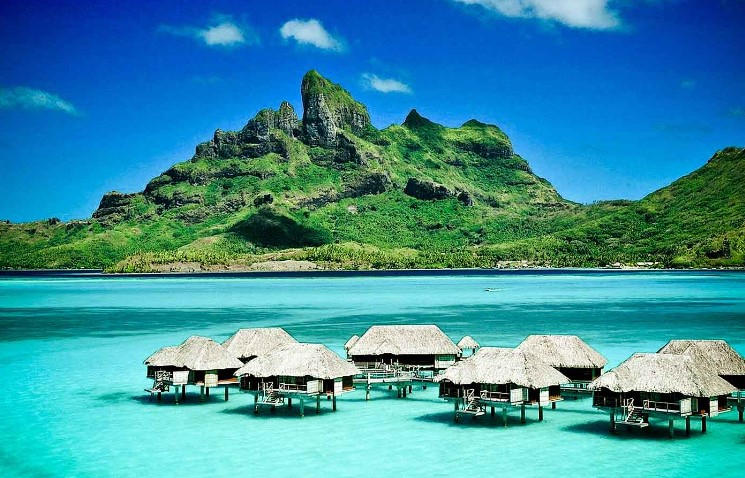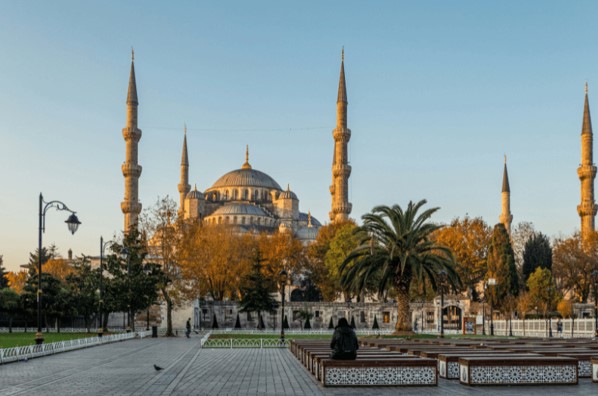The U.S. State Department issues travel advisory levels for more than 200 countries globally, continually updating them based on a variety of risk indicators such as health, terrorism and civil unrest. Travel advisory levels range from Level 1, which means exercise normal precautions, to Level 4, which means do not travel.
Nearly 20 countries, or about 10{6932ee47e64f4ce8eedbbd5224581f6531cba18a35225771c06e4f1b3f0d9667}, have a Level 4: “Do Not Travel” advisory as of Jan. 9. In Level 4 countries, the U.S. government may have “very limited ability” to step in should travelers’ safety or security be at risk, according to the State Department. Crime, civil unrest and terrorism are common risk factors associated with Level 4 countries.
Places With a Level 4 Travel Advisory
These are the primary areas the U.S. government says not to travel to right now, in alphabetical order:
Jump to Place:
The Central Asian country is wrestling with “armed conflict, civil unrest, crime, terrorism, and kidnapping,” according to the State Department. U.S. citizens are specifically at risk for violence or kidnapping. In December 2022, the government reinstituted public floggings and executions, and women’s rights are disappearing under Taliban control. The U.S. Embassy in Kabul halted operations in August 2021.
Belarus, Russia’s neighbor, has been flagged for “arbitrary enforcement of laws, the risk of detention, the Russian military attack on neighboring Ukraine, and the buildup of Russian military in Belarus along the border with Ukraine.” The U.S. Embassy in Minsk halted operations in February 2022.
Terrorism, crime and kidnapping are plaguing this West African nation. Terrorist attacks may target hotels, restaurants and schools with little to no warning, and the East and Sahel regions of the country are under a state of emergency.
While there have not been specific incidents of U.S. citizens targeted with violence or crime, violent crime and sudden closure of roads and borders is common. The advisory states that “Embassy Bangui’s limited capacity to provide support to U.S. citizens, crime, civil unrest, and kidnapping” is a factor in its assessment.
Armed conflict and civil unrest are the primary reasons to not travel to this Southeast Asian country, which experienced a military coup in early 2021. COVID-19 restrictions, limited health care resources, wrongful detentions and “areas with land mines and unexploded ordnance” are also listed as risk factors.
Hamas, a foreign terrorist organization as designated by the State Department, controls much of the Gaza Strip, which shares borders with both Israel and Egypt. Terrorism, civil unrest and armed conflict are the primary risk factors. The advisory states that “sporadic mortar or rocket fire and corresponding Israeli military responses may occur at any time.”
Concerns about risk of kidnapping, crime and civil unrest are all prominent risk factors for Haiti, which borders the Dominican Republic in the Caribbean Sea. The country has experienced a number of natural disasters, which along with economic and social instability, contribute to chronic poverty. In October, the country’s prime minister asked for international security forces to help combat ongoing gang violence, stating that “the whole country has been taken hostage.” The travel advisory states that “U.S. citizens should depart Haiti now in light of the current security and health situation and infrastructure challenges.”
Kidnapping and wrongful detentions are risk factors for all travelers, while U.S. citizens are specifically at risk for “arbitrary arrest and detention.” U.S.-Iranian nationals such as students, journalists and business travelers have been arrested on charges of espionage and threatening national security.
This winter, for the first time in four decades, this war-torn Middle Eastern nation is hosting the Arabian Gulf Cup, an eight-nation international soccer tournament. But while the country appears optimistic about a more stable future, the U.S. government still puts Iraq on its “no-go” list. The State Department cites “terrorism, kidnapping, armed conflict [and] civil unrest” as cause for the country’s Level 4 distinction. Iraq’s northern borders, and its border with Syria, are especially dangerous.
Following the end of its dictatorship over a decade ago, Libya has been wrought with internal conflict between armed groups in the East and West. Armed conflict, civil unrest, crime, kidnapping and terrorism are all risk factors. U.S. citizens have been targets of kidnapping for ransom, with terrorists targeting hotels and airports frequented by Westerners. The U.S. Embassy in Tripoli halted operations in 2014.
After experiencing a military coup in 2020, crime, terrorism and kidnapping are all prevalent threats in this West African landlocked nation. In July 2022, non-emergency U.S. government employees and their families were ordered to leave the country due to higher risk of terrorist activity.
Each state in Mexico is assessed separately for travel advisory levels. Six of the 32 states in Mexico are designated as Level 4: Colima, Guerrero, Michoacan, Sinaloa, Tamaulipas and Zacatecas. Crime and kidnapping are listed as the primary risk factors throughout the country.
U.S. passports are not valid for travel “to, in, or through” this country, home to one of the world’s longest-running dynastic dictatorships. The travel advisory states that the Level 4 distinction is due to “the continuing serious risk of arrest and long-term detention of U.S. nationals.”
The travel advisory for Russia cites its invasion of Ukraine, harassment of U.S. citizens by Russian government officials, and arbitrary law enforcement as a few of the reasons for the Level 4 designation. Chechnya and Mount Elbrus are specifically listed as Level 4 regions. Terrorism, civil unrest, health, kidnapping and wrongful detention are all noted as risks.
A severe drought resulting from five failed rainy seasons in a row has caused food prices to shoot up, putting the East African country at risk of famine amid conflict with Islamist insurgents. Violent crime is common throughout Somalia, pirates frequent its coast off the Horn of Africa, and medical facilities, where they exist, have limited capacity. Crime, terrorism, civil unrest, health and kidnapping are all risk factors.
Six journalists who work with state-run South Sudan Broadcasting Corporation are currently detained over footage of President Salva Kiir, who has been in power since the country separated from Sudan in 2011. Crime, kidnapping and armed conflict are the primary risk factors, with violent crime common throughout the country. Weapons are readily available, and travelers have been victims of sexual assault and armed robbery.
Following a military coup in 2021 and subsequent protests, civil unrest is the primary risk factor for Africa’s third largest country by area. Crime, terrorism, kidnapping and armed conflict are also noted. Crime is less frequent in Khartoum, the capital. Sporadic protests and civil unrest can result in disruptions to internet and cell phone service.
The advisory states that “No part of Syria is safe from violence,” with terrorism, civil unrest, kidnapping, armed conflict and risk of unjust detention all potential risk factors. U.S. citizens are often a target for kidnappings and detention. The U.S. Embassy in Damascus halted operations in 2012.
Russian setbacks in their invasion of Ukraine have buoyed hopes in the country for 2023. However, Ukraine is a Level 4 country due to “Russia’s full-scale invasion,” with crime and civil unrest also noted as risk factors. The Ukrainian government declared a state of emergency in February 2022.
Human rights abuses and lack of health care plague this South American nation, which has been in a political crisis since 2014. In 2019, diplomatic personnel were withdrawn from the U.S. Embassy in Caracas. Threats in the country include crime, civil unrest, kidnapping, wrongful detention and poor health infrastructure.
Six of the nine risk factors defined by the State Department – terrorism, civil unrest, health risks, kidnapping, armed conflict and landmines – are all present in Yemen. Despite private companies offering tourist visits to the Yemeni island of Socotra, the U.S. government argues those arranging such visits “are putting tourists in danger.” Civil war and cholera are also both present throughout the country. The U.S. Embassy in Sanaa halted operations in 2015.
In the last five weeks, the State Department updated travel advisory levels for more than 10 countries. Travel advisory levels can change based on several factors in a nation, such as increased civil unrest, policies that affect human rights or higher risks of unlawful detention.
The State Department has given more than 30 countries an assessment of Level 3, meaning it recommends people “reconsider travel” to those destinations.
One of those 30 Level 3 countries is China. The Asian powerhouse became a Level 3 country in late 2020, and remains at that level due to “the surge in COVID-19 cases, arbitrary enforcement of local laws, and COVID-19-related restrictions,” according to an update in December. While China was able to control the spread of COVID-19 earlier in the pandemic with strict lockdown policies, it has now eased restrictions and is once again grabbing headlines for increasing cases. As of Jan. 5, 2023, travelers from China, Hong Kong and Macau will need to provide a negative COVID-19 test before boarding flights to the U.S.
Peru, a South American country that has recently been plagued by political violence, is also on the Level 3 list. Protests continue in the country, which is in turmoil following the ouster of a democratically elected president.
More than 60 countries are currently at Level 2, meaning the State Department recommends travelers “exercise increased caution” when traveling to those destinations. Among those 60 countries is Brazil, which has recently grabbed headlines for its political turmoil. On Jan. 8, thousands of far-right supporters of former Brazilian President Jair Bolsonaro stormed the country’s Congress, Supreme Court and presidential palace to protest the results of the country’s presidential election.
Brazil, as the largest country in South America, has been designated Level 2 because of crime since April 2022. It had previously been designated Level 4 due to COVID-19.




More Stories
Maximizing Your Savings – Expert Strategies For Travel Discounts
Unlocking Growth: 15 Strategies for Boosting Leads and Customers for Your North Georgia Business
Indonesia Travel Advice & Safety